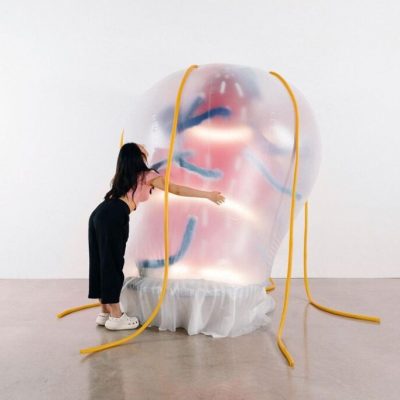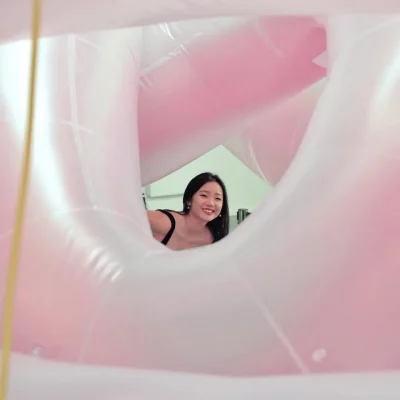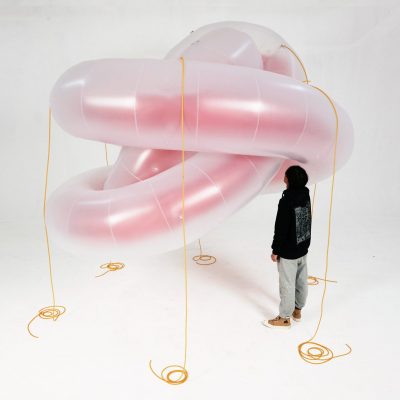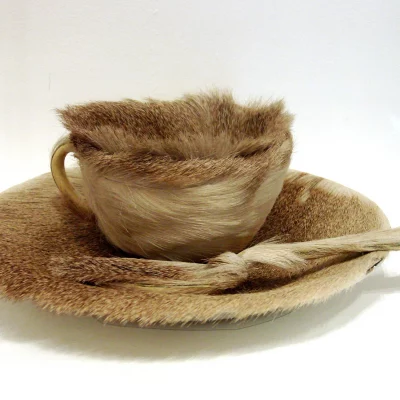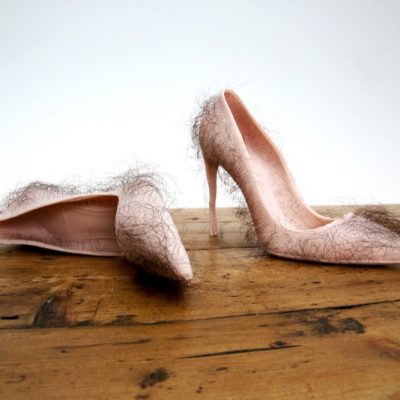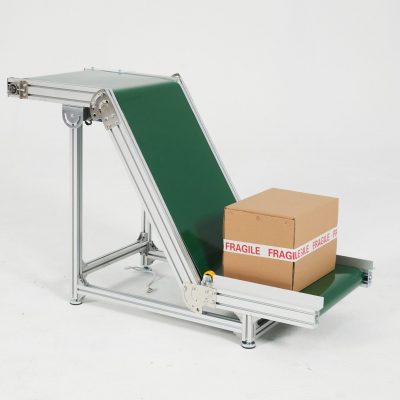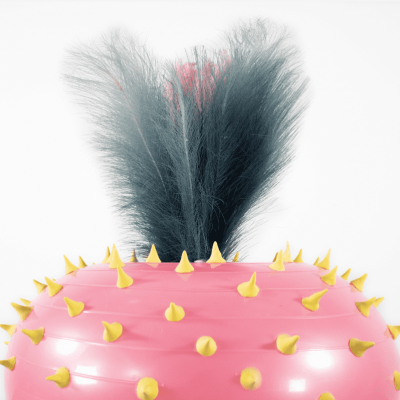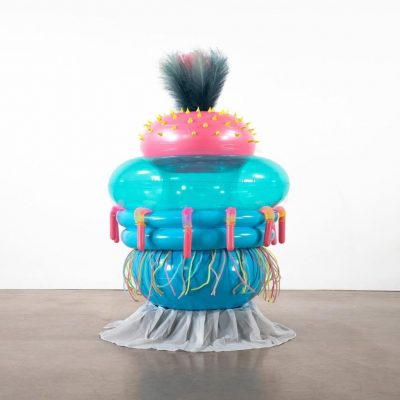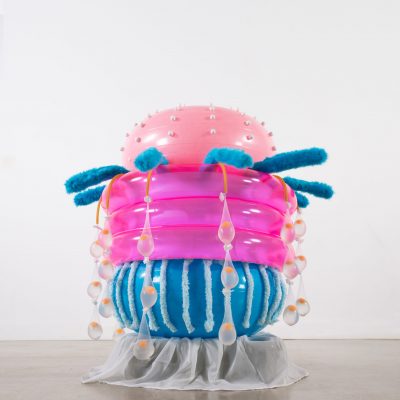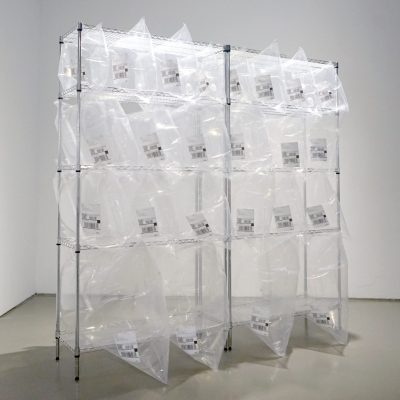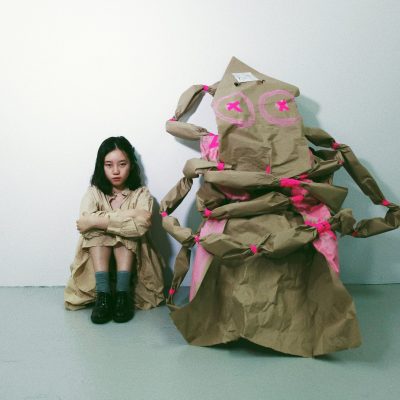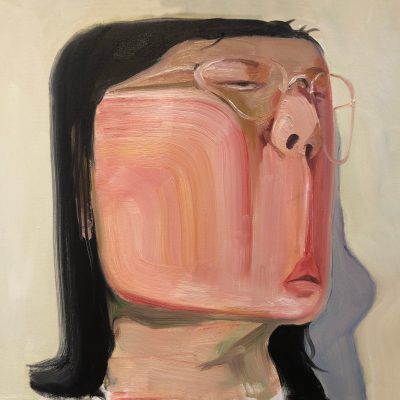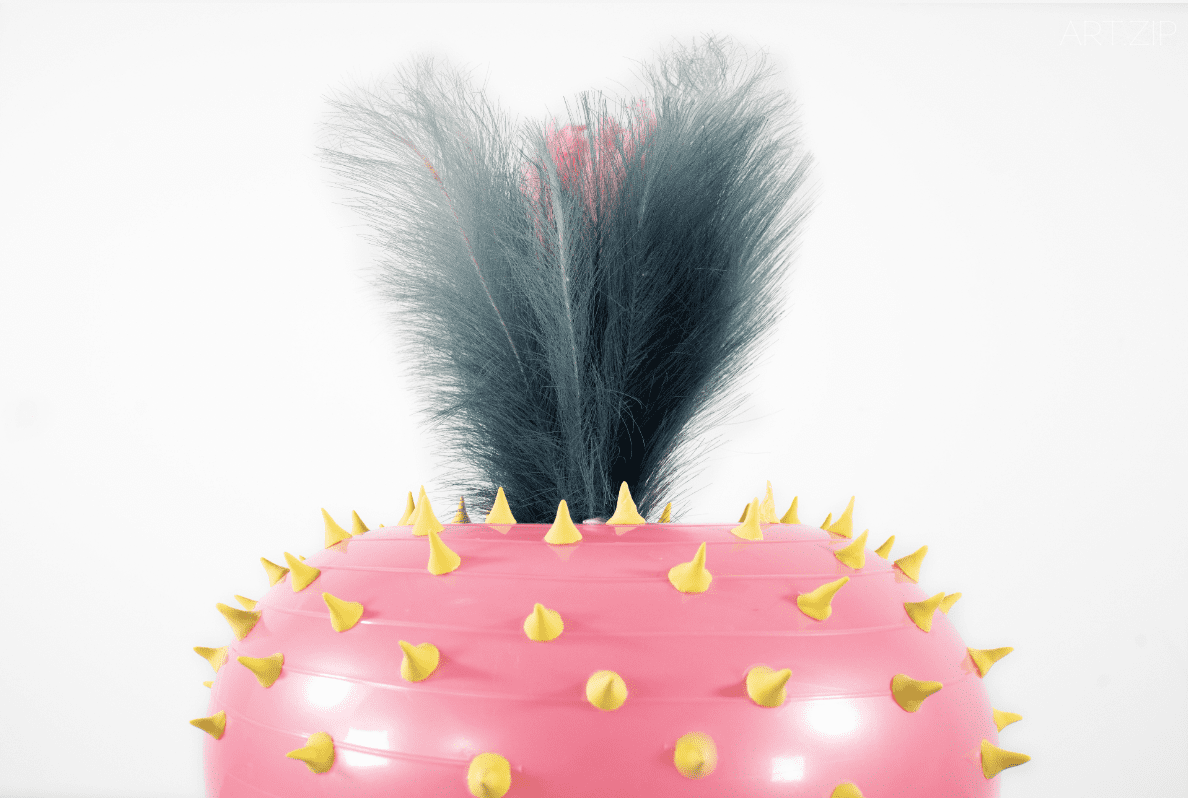
RONG BAO IS ME
23 FEB – 12 MAY 2024
GALLERY 4,Saatchi Gallery
“All forms of allure come to our attention through surprise or fascination, since we are not exactly certain about what it is we are dealing with, though we witness to its qualities.” –Graham Harman
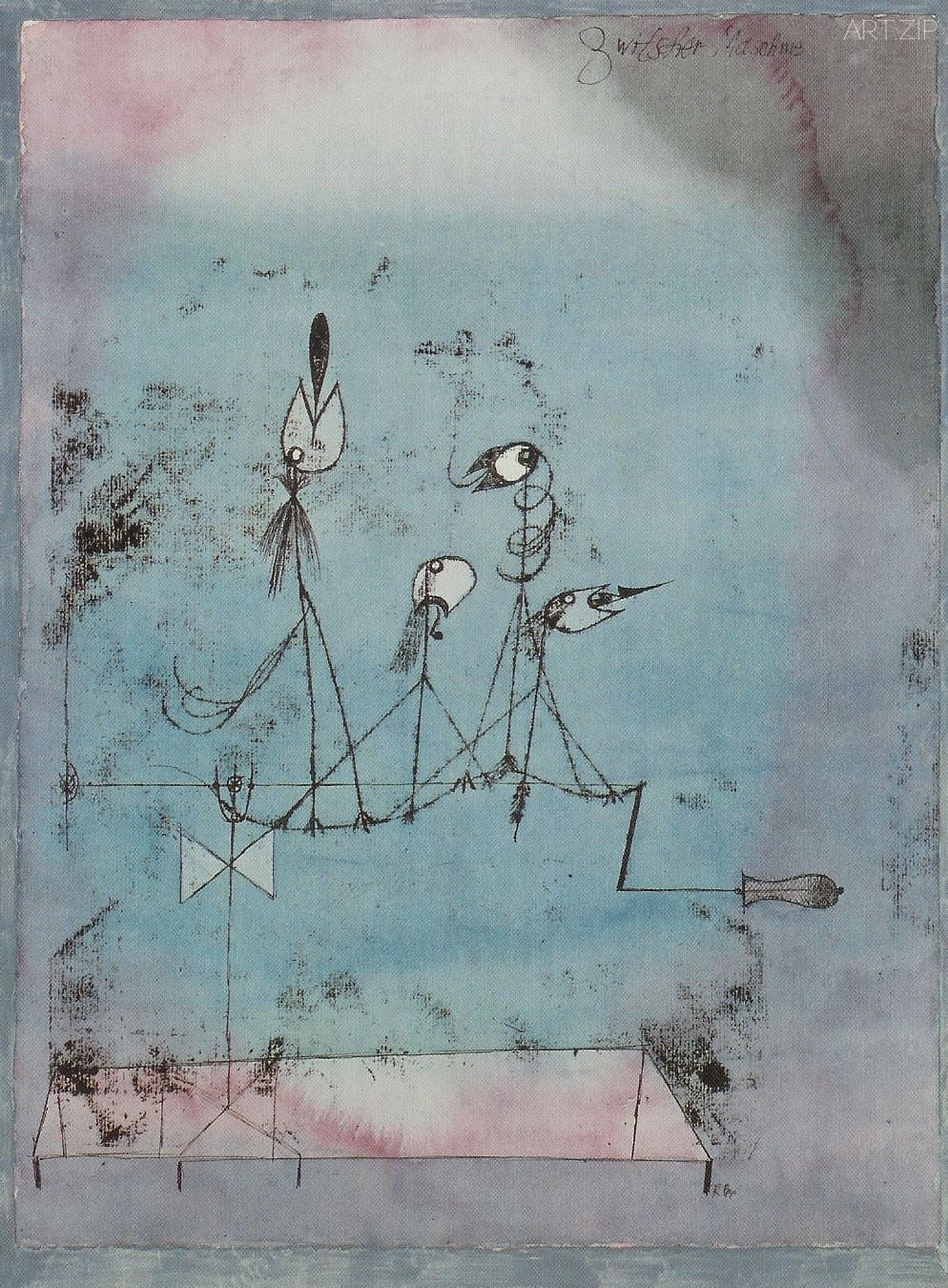
Paul Klee, Twittering Machine, 1922. ©Paul Klee
When Paul Klee painted his work ‘Twittering Machine’ (1922) he was suggesting a conjunction of machines and nature. This was born out of a presentation of an image of free beauty, birds rendered in a choir of song, with the reality of their being enslaved with the dark machinations of infernal capitalist logic. Such a tiny, delicate drawing suggesting a deep underlying terror, with nothing as it quite appears within the glance of the eye.
In a current exhibition ‘Rong Bao is Me’ there are a whole array of machines on display, pulsing, twisting, and turning with each element asserting its own logic in ways that suggest an organic mode of becoming, as opposed to just machinic semblance. A playful mood seems on offer, with a lightness of touch running through the whole assemble that acts as a magnate for childhood like reverie more than seriously invested adult attention. Then this sense is born out of just a cursory glance, so perhaps this produces an errant reading of what is at hand. Certainly, there is a compelling production of pleasure (as excess) but then is this a pleasure tinged by darkness that mixes the free play of intuition, invention, and imagination into networks of desiring production. This constellation of desire, machines, invention, excess, has a suggestion of ‘desiring-machines’ that are to be discovered as a construct in Deleuze and Guattari. Such a machinic order generate flows and codes of becoming, working at different speeds and frequencies, participating within various milieus, all within serialities of outcomes that remain open to new conjunctions. This moves beyond the dualisms within the formations of subject and objects. Rather than a series of progressions or narratives, the works produce fields of saturations and folds in which localised play is joined to a cosmic dance of elements. All in all, a case of machines that channel desire, and desires that programme machines.
The question of desire also leads into the question of fetishism and whether this pertains to these works. It is partly the relationship of conjunctions that are being entertained, as in Meret Oppenheim’s ‘Luncheon in Fur’ (1936) or more recently Zhu Tian’s ‘Babe’ (2013). In these two works, it is not just the conjunction of the inorganic and the organic generates displacement, but also how the material in question perform or release affects. Fetishism also invariably joins to abjection which performs as a quality between the object and the subject. Plastic has its roots in the names of Greek shepherds such as polystyrene and was initially viewed as a wonder material but now is seen as (trashy) base matter capable of being moulded, receiving shape, or undergoing deformation. As possibly one of the most toxic pollutants, it is a material born out of industrial transformation of nature that in turn transforms its relationship to nature as a pollutant of it, and as such, it is invariably viewed as being in excess. In its foundation within Modernity, it signified an optimistic, popish mode of the forever new, whereas within the turn towards a late or exhausted Modernity its connotations are imbued with the rhetoric of accumulated dysfunction. Returning though to a broader signifying chain of qualities pertaining to fetishism, abjection, animation, fantasy, excess, absurdity, and performance that can be detected in the work of this exhibition, they are also part of a sign economy of evasion or complication that render the relationship to the perception of the work complex. The trashy, saturated, playful surfaces are not just entertained in a knowing or critical fashion, but also pose questions that are evident within more abstracted figures that might cohere within and below such surfaces. Something is moved and within what moves, an allure is created. Yet there is also something else in the form of that which withdraws or resides in an elsewhere of what stands in open visibility. An example of this is in the work ‘Fragile’ that points towards a much darker form of repetition-compulsion that underlies the futility or the cracking up of the logic of a machinic assembly that is simply compelled to go round and around in the forever of empty circulation.
Returning to Paul Klee the twittering is without finality because the machinery can function without the birds, but it is the birds that produce the allure. The allure is what attracts, whereas the machine is what sustains. Each element conforms to its nature but also have the capacity to go beyond or even less than that nature. What performs in this show is the display of the uncertainty of what is beyond or less than the allure of what is given. Twittering is given over to a more pronounced trembling, visibility to more hidden gesture, forms opening to the possibility of deformation. Do we stand before, or stand with, and what is it that is in circulation? Pleasure comes and goes; pastel-coloured moods circulate, but finally the play of aesthetic rupture and rapture endures within a suggested closure of the gap between being and machine. As the gap closes, it is replaced by valves and ciphers that produce connections to other assemblages and the new is generated by virtue of the different forms of compression achieved. A case of light touches serving as a disguise for more weighty figures. As in the work by Paul Klee, these works appear to be floating free of the force of gravity. This is perhaps connected to the impulse to offer an imaginary elsewhere to a world that is saturated with heaviness.
即使我們能瞥見它的本質,所有形式的誘惑都能用讓人驚訝或著迷的形式引起我們的注意,其原因在於一種未知。
——格雷厄姆·哈曼
當保羅·克利(Paul Klee)繪制他的作品《鳴囀機(Twittering Machine,1922)》時,他展現了機器與自然的結合。這個作品起始於對自由之美形象的呈現,鳥兒在合唱,實際上卻被邪惡的資本主義邏輯下的黑暗陰謀所奴役。這樣一幅微小而精緻的畫作暗示著一種深層次的恐懼:只有通過不斷的觀看,完整的信息才會浮出水面。
在當前的展覽《包蓉是我(RONG BAO IS ME)》中,觀者將看到一系列機械作品。雖然有著機械的外觀,它們律動、扭曲、旋轉,每個元素都在以一種有機的方式表達自己的邏輯。展覽中似乎流淌著一種俏皮嬉戲的氛圍,輕盈的觸感貫穿始終,成年人的嚴肅感彷彿消失,因為童年般的遐想取而代之。不過,這種感覺僅僅來自浮光掠影的一瞥,因而誤讀可能產生。誠然,她的作品里有著一種引人入勝的彷彿過剩的愉悅感,但下一刻又出現了一種帶有暗黑色彩的愉悅感:它將直覺、創造和想象肆意把玩,混雜到慾望生產的網絡中。
在德勒茲和瓜塔里(Deleuze and Guattari)的理論中,這種慾望、機器、創造、過剩的組合被建構為「慾望機器」(desiring-machines)。以不同的速度和頻率工作並參與在各種環境中,慾望機器的秩序能夠產生關於存在與變化的流動性和代碼,並在結果中保持對新的關聯的開放——這超越了主體與客體的二元對立。這些作品並非一系列的進展或敘事,而是生產著飽和與折疊的領域,其中局部的遊戲和無限的元素共舞。總之,這是機械引導慾望、而慾望又反過來控制機械的一次展示。
關於慾望的討論也引出戀物,以及戀物是否與這些作品相關的問題。在一定程度上,我們探討的是作品與結合性的關聯,例如梅雷特·奧本海姆(Meret Oppenheim)的《皮毛餐具》(Luncheon in Fur,1936年)和更近年的朱田的《寶貝》(Babe,2013年)。在這兩件作品中,無論是無機物和有機物的結合,還是所選的材料如何表現或是釋放情感,都在悄然錯位。戀物也總是與「排斥」聯繫在一起,而「排斥」則是客體與主體之間的一種特質。
塑料,起源於希臘牧羊人的名字,如聚苯乙烯(polystyrene),最初被認為是一種神奇的材料,但現今卻被視為一種低質、易塑形、易變形的基礎物質。塑料可能是毒性最強的污染物之一,這種材料源於對自然的工業改造,而這種改造又改變了它與自然的關係,使之成為污染物,因此,它總被認為是過剩的。在現代性中,塑料象徵著一種永遠嶄新的、樂觀的、流行的模式,而在轉向晚期現代性或現代性的衰竭之時,它的內涵則累積了功能障礙的暗示。
在本次展覽的作品中,可以發現與戀物、排斥、動畫、幻想、過剩、荒謬和表演有關的、更廣泛的意義鏈,它們也是回避或複雜化的符號經濟的一部分,使得作品與觀眾的感知關係變得複雜。低廉、飽和、俏皮的表象並不僅以一種明知或批判的方式來娛樂,同時也提出了一些在表面之下的更為抽象的問題。有些東西被打動了,而打動人心的東西又產生了一種誘惑力。然而,也有一些其他的東西,以某種方式隱退或存在於一個不為人知又公開可見的場域中。作品《脆弱》(Fragile)就是一例,它指向一種更為陰暗的強迫性重復,暗示了機械組合邏輯的徒勞或崩潰,它只是被迫在空洞的循環中周而復始。
讓我們回到保羅·克利;鳥鳴之聲並沒有終結,因為機械雖然能在沒有鳥兒的情況下運作,但是散髮誘惑的是鳥兒。誘惑產生吸引,而機器可維持長久。每種元素都符合其本質,但也有能力超越或是低於其本質。本次展覽所呈現的,是一種對超越或低於裝置所給出的誘惑的不確定性。鳥鳴被賦予了更顯著的震顫,可見性被賦予了更隱蔽的姿態,而形態被賦予了變形的可能性。於是問題開始顯現:我們是站在作品的前面,還是作品的旁邊,還是我們的位置不斷循環?愉悅來去匆匆,彩色情緒流轉,但最終,美學的破裂和狂喜的玩味持續於存在與機器的結合之間。隨著兩者間的縫隙閉合,它們被閥門和密碼所取代,產生了與其他組合體的連接,而新的東西則通過不同形式的壓縮而產生:被壓縮後的輕巧的觸感掩飾著更為厚重的東西。
和保羅·克利的作品一樣,包蓉的作品似乎也不受地心引力的影響,自由地漂浮著。這或許與一種衝動有關——為這個充斥著沈重感的世界提供一個想象中的別處。
Text by Jonathan Miles
Translated by Gong Hengzhi
Edited by Michelle Yu

